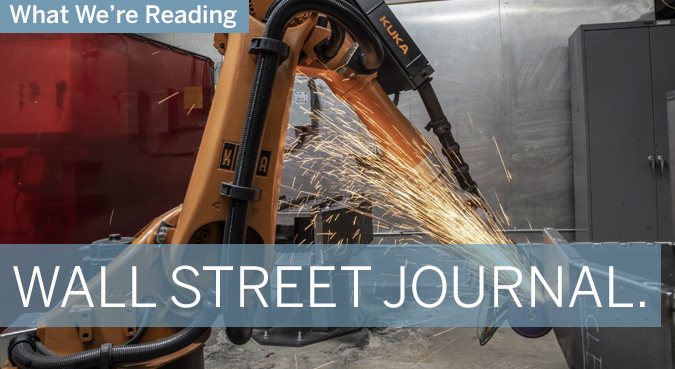
Robots Pick Up More Work at Busy Factories
Wall Street Journal, 5.29.22 – Robots are turning up on more factory floors and assembly lines as companies struggle to hire enough workers to fill rising orders.
Orders for workplace robots in the U.S. increased by a record 40% during the first quarter compared with the same period in 2021, according to the Association for Advancing Automation, the robotics industry’s trade group. Robot orders, worth $1.6 billion, climbed22% in 2021, following years of stagnant or declining order volumes, the group said.
Rising wages and worker shortages, compounded by increases in Covid-19-related absenteeism, are changing some manufacturers’ attitudes about robotics, executives said. “Before, you could throw people at a problem instead of finding a more elegant solution,” said Joe Montano, chief executive officer of Delphon Industries LLC, a maker of packaging for semi-conductors, medical devices and aerospace components.
Delphon, based in Hayward, Calif., lost 40% of its production days during January when the corona virus spread through its workforce. The disruption accelerated the company’s purchase of three additional robots earlier this year, Mr. Montano said.
Manufacturers in the U.S., where workers typically have been abundant and wages stable, have been slower to embrace robotics than those in some other industrialized countries. The number of robots deployed in the U.S. per 10,000 workers has traditionally trailed countries such as South Korea, Japan and Germany, according to the International Federation of Robotics.
The use of industrial robots in North America for years had been concentrated in the automotive industry, where robots took on repetitive tasks such as welding on assembly lines. While auto makers and manufacturers of auto components accounted for 71% of robot orders in 2016, their share declined to 42% in 2021, the automation association said. Meanwhile, robots made inroads into other sectors including food production, consumer products and pharmaceuticals. Executives said improved capabilities are allowing robots to be programmed for more-complex tasks requiring a mixture of strength and nimbleness.
View the entire article here.



